The Ford Mondeo, the car once used as a symbol of Britain’s aspirational working-class swing voters, has run out of road.
Ford said it would cease production of the Mondeo at its plant in Valencia, Spain, early next year, bringing down the curtain on nearly 30 years of production after shifting 5m of the hugely successful model.
The Mondeo was the first Ford to be developed as a global car – “monde” in French – as the carmaker aimed to cut costs by reducing the number of models it produced. Launched in 1993, it was a big hit in the UK and Europe, becoming a status symbol at a time when Britain’s middle managers were regularly handed company cars by their employers.
About 375,000 Mondeos were sold across Europe in 1994, and almost 87,000 in the UK alone in 2001. By 2020, however, annual UK sales had dwindled to 2,400, killed off by the rise in sports utility vehicles as well as the industry going electric.
Tom Leathes, CEO of secondhand car website Motorway.co.uk, said there were few buyers now for used Mondeos, either. “SUVs have been eating the Mondeo’s lunch for years now,” he said. “In the 90s, the Mondeo was affordable and stylish – the kind of car that said ‘I don’t have a Mercedes, but I don’t want some boring family estate car either’. There just isn’t much demand for them in the used car market, while the Ford Focus, on the other hand, is in our top five cars.”
But the car forged an enduring role in British political discourse after Tony Blair identified “Mondeo man” as a key target for New Labour in 1996. Blair based the character on a self-employed electrician he met while out canvassing, who had bought his own council house and his own car. Winning over such thirty- and fortysomething homebuyers would be key to victory over the Tories, he decided.
Since that landslide victory successive political leaders have tried to identify their own swing voters, such as “Worcester woman” (a working-class woman with no interest in politics) and more recently, “Workington man” (a 45-plus northern leaver, ex-Labour voter and rugby league fan), as they try to figure out the key issues that matter to the electorate.
While voter caricatures such as Mondeo man capture the zeitgeist, others are best forgotten, such as William Hague’s “pebbledash people” – married couples aged 35-50, who were white-collar workers living in semi-detached, often pebbledashed, homes in the suburbs. Then there was the Bacardi Breezer generation – a term coined by ex-Cabinet minister Stephen Byers, who wanted Labour to focus on 18-to-25-year-olds in danger of being lost to the democratic process.
To stay in fashion the Mondeo, which won What Car’s award for car of the year in 1993 and again in 2001, had several design refreshes. In 2003, a decade after its launch, Jeremy Clarkson wrote in a Times column that it was still “one of the best mid-range cars”.
“It’s comfortable, spacious, surprisingly well made and much more of a hoot to drive than you might imagine,” he wrote. “Think of it, if you like, as a librarian with a G-string under the tweed.”
The car’s unlikely sex appeal was boosted by a drive-on part in the 2006 James Bond movie Casino Royale. In the film, Daniel Craig’s Bond swaps an Aston Martin for a top of the range five-door Mondeo, albeit with special Tonic blue paintwork and not quite Q-level gadgetry of keyless entry and a start button.
But just as Worcester woman, who had been associated with suburban aspirations in the noughties, had become “Aldi mum” by the time of the 2015 election, Mondeo man is now probably driving an SUV.
Auto trade publications had earlier this year reported that an updated Mondeo was in development, taking design cues from crossover SUVs, but Ford said there would not be an update.
Analysts said the writing has been on the wall for the Mondeo for some time as families increasingly plump for bulkier SUVs, which offer a higher driving position and sometimes more room, although often at the cost of higher carbon dioxide emissions.
Announcing the decision, Ford pointed to changing “customer preferences”. Indeed, two in every five cars Ford sold in 2020 were SUVs or crossovers – SUV-style cars with more limited off-road ability, such as its Kuga.
Ford is also looking to move towards all-electric sales in Europe by 2030, as it belatedly tries to catch up with rivals who are further ahead in developing electric cars. The Mondeo had been offered as a hybrid, but will never be available as a rechargeable plug-in version.
The Valencia plant will build more hybrid engines and battery packs for electric cars. Kieran Cahill, vice-president for manufacturing at Ford of Europe, said the changes represented “another step on Ford’s electrification journey, providing a bridge to an all-electric passenger vehicle future”.
